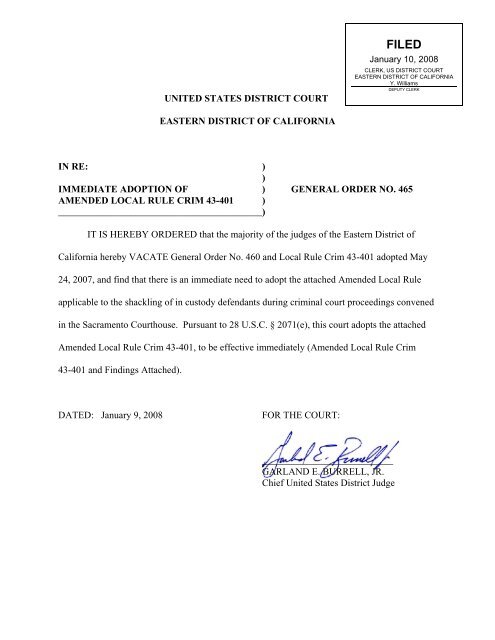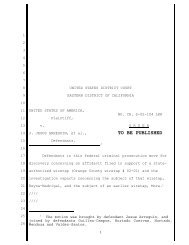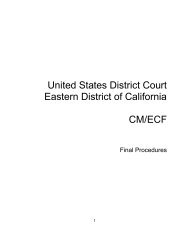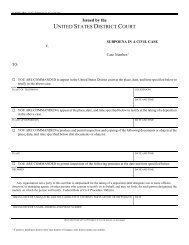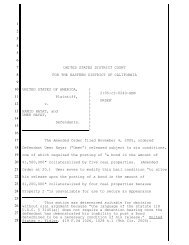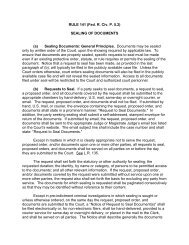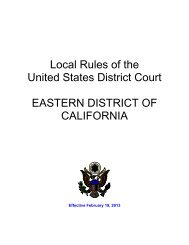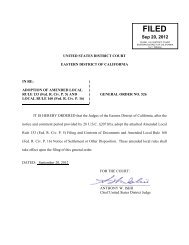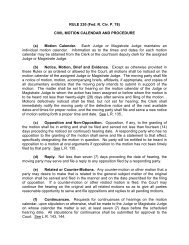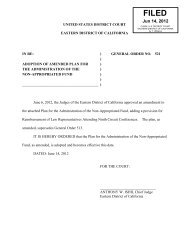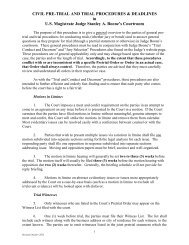General Order No. 465 - Eastern District of California
General Order No. 465 - Eastern District of California
General Order No. 465 - Eastern District of California
Create successful ePaper yourself
Turn your PDF publications into a flip-book with our unique Google optimized e-Paper software.
UNITED STATES DISTRICT COURT<br />
FILED<br />
January 10, 2008<br />
CLERK, US DISTRICT COURT<br />
EASTERN DISTRICT OF CALIFORNIA<br />
Y. Williams<br />
DEPUTY CLERK<br />
EASTERN DISTRICT OF CALIFORNIA<br />
IN RE: )<br />
)<br />
IMMEDIATE ADOPTION OF ) GENERAL ORDER NO. <strong>465</strong><br />
AMENDED LOCAL RULE CRIM 43-401 )<br />
__________________________________________)<br />
IT IS HEREBY ORDERED that the majority <strong>of</strong> the judges <strong>of</strong> the <strong>Eastern</strong> <strong>District</strong> <strong>of</strong><br />
<strong>California</strong> hereby VACATE <strong>General</strong> <strong>Order</strong> <strong>No</strong>. 460 and Local Rule Crim 43-401 adopted May<br />
24, 2007, and find that there is an immediate need to adopt the attached Amended Local Rule<br />
applicable to the shackling <strong>of</strong> in custody defendants during criminal court proceedings convened<br />
in the Sacramento Courthouse. Pursuant to 28 U.S.C. § 2071(e), this court adopts the attached<br />
Amended Local Rule Crim 43-401, to be effective immediately (Amended Local Rule Crim<br />
43-401 and Findings Attached).<br />
DATED: January 9, 2008<br />
FOR THE COURT:<br />
___________________________<br />
GARLAND E. BURRELL, JR.<br />
Chief United States <strong>District</strong> Judge
RULE Crim 43-401<br />
SHACKLING OF IN-CUSTODY DEFENDANTS<br />
(a) Applicability. This rule is applicable to the shackling <strong>of</strong> in custody<br />
defendants during criminal court proceedings convened in the Sacramento<br />
Courthouse.<br />
(b)<br />
Definitions.<br />
(1) “Crime <strong>of</strong> Violence” means:<br />
(A) an <strong>of</strong>fense that has an element <strong>of</strong> the <strong>of</strong>fense the use,<br />
attempted use, or threatened use <strong>of</strong> physical force against the person or property<br />
<strong>of</strong> another;<br />
(B) any other <strong>of</strong>fense that is a felony and that, by its nature,<br />
involves a substantial risk that physical force against the person or property <strong>of</strong><br />
another may be used in the course <strong>of</strong> committing the <strong>of</strong>fense; or<br />
(C) any felony under chapter 109A (18 U.S.C. §§ 2241 et<br />
seq.), 110 (18 U.S.C. §§ 2251 et seq.), or 117 (18 U.S.C. §§ 2421 et seq.) <strong>of</strong> Title<br />
18.<br />
(2) “Fully Shackled” means leg restraints (including waist chains),<br />
and handcuffs.<br />
(3) “Long Cause Proceeding” means a proceeding that is<br />
expected to last at least 30 minutes, such as an evidentiary hearing.<br />
(c) Shackling at Initial Appearance. Unless the Court determines<br />
otherwise, at the commencement <strong>of</strong> initial appearances, all in custody defendants<br />
shall be in leg restraints (including waist chains).<br />
(d) Shackling Determination and Waiver. At the initial appearance,<br />
unless the in custody arrestee/defendant waives a shackling determination, by<br />
express waiver or by failure to mention it, the Court shall determine whether the<br />
shackling <strong>of</strong> the in custody defendant in leg restraints (including waist chains) is<br />
necessary and/or sufficient. When making a determination on restraints, the<br />
Court shall, where practical and immediately available, consider the following:
(1) The nature and circumstances <strong>of</strong> the <strong>of</strong>fense charged,<br />
including whether the <strong>of</strong>fense is a crime <strong>of</strong> violence, a Federal crime <strong>of</strong> terrorism<br />
or involves a minor victim or a controlled substance, firearm, explosive, or<br />
destructive device,<br />
(2) The weight <strong>of</strong> the evidence against the in custody defendant;<br />
including:<br />
(3) The history and characteristics <strong>of</strong> the in custody defendant,<br />
(A) the in custody defendant’s character, physical and<br />
mental condition, past conduct, history relating to drug or alcohol abuse, criminal<br />
history, and record concerning appearance at court proceedings; and<br />
(B) whether, at the time <strong>of</strong> the current <strong>of</strong>fense or arrest, the<br />
in custody defendant was on probation, on parole, or on other release pending<br />
trial, sentencing, appeal, or completion <strong>of</strong> sentence for an <strong>of</strong>fense under Federal,<br />
State, or local law;<br />
(4) Whether the in custody defendant will be one <strong>of</strong> multiple<br />
defendants appearing in court proceedings in tandem.<br />
(e) Default Determination. The Court’s shackling determination made<br />
under subsection (d) above, or leg restraints (including waist chains) if no<br />
shackling determination is made under subsection (d), will be the default for the in<br />
custody defendant in all subsequent proceedings, unless further information<br />
demonstrates otherwise.<br />
(f) Persons in Jail Facilities. <strong>No</strong>twithstanding any other provision <strong>of</strong><br />
this rule, a person who has been housed in a jail facility for less than one<br />
business day prior to the initial appearance in this Court may be fully shackled in<br />
the discretion <strong>of</strong> the United States Marshal's Service, through the United States<br />
Marshal or a Deputy Marshal ("Marshal"), provided the Marshal finds justification<br />
for full shackling under at least one <strong>of</strong> the factors set forth in (d)(1), (3), or (4).<br />
(g) Multiple Defendants. <strong>No</strong>twithstanding any other provision <strong>of</strong> this<br />
rule, in situations where two or more in custody defendants are brought into the<br />
courtroom together as a result <strong>of</strong> the Court’s attempt and need to manage the<br />
Court calendar in a timely fashion, the defendants will be fully shackled unless<br />
the Court determines otherwise on its own motion.
(h) Unshackling <strong>of</strong> Writing Hand. When an in custody defendant is<br />
fully shackled:<br />
(1) At Rule 11 proceedings, the in custody defendant shall be<br />
permitted the unshackled use <strong>of</strong> the defendant’s writing hand, unless the Marshal<br />
recommends full shackling for particularized reasons, and the Court adopts the<br />
recommendation.<br />
(2) In long cause proceedings, the in custody defendant shall be<br />
permitted the unshackled use <strong>of</strong> the defendant’s writing hand, unless the Marshal<br />
recommends full shackling for particularized reasons, and the Court adopts the<br />
recommendation. The in custody defendant shall remain seated at the defense<br />
table, except when giving testimony.<br />
(i) Jury Proceedings. This rule does not apply to trial proceedings at<br />
which a jury is being chosen or has been impaneled.
FINDINGS 1<br />
Background<br />
1. The <strong>Eastern</strong> <strong>District</strong> <strong>of</strong> <strong>California</strong> adopted <strong>General</strong> <strong>Order</strong> 441 on February 15, 2006,<br />
which prescribed full shackling <strong>of</strong> all detained defendants at pretrial proceedings, except<br />
Rule 11 and long cause proceedings, to assure the safety <strong>of</strong> all persons in the courtroom,<br />
in accordance with the recommendation <strong>of</strong> the United States Marshal. 2 Some <strong>of</strong> the<br />
findings attached to <strong>General</strong> <strong>Order</strong> 441 follow:<br />
[] The <strong>Eastern</strong> <strong>District</strong> <strong>of</strong> <strong>California</strong> has a heavy criminal caseload.<br />
Criminal calendars frequently are lengthy and require the<br />
movement <strong>of</strong> many detained prisoners in and out <strong>of</strong> the courtroom.<br />
[] Most criminal proceedings are brief such that the time in which<br />
a defendant is before the court fully shackled is minimal.<br />
[] The alternatives to full shackling are not practical or would<br />
merely substitute the presence <strong>of</strong> much greater numbers <strong>of</strong> deputy<br />
marshals for physical restraints, with no significant increase in<br />
decorum or dignity for the defendant. The resources <strong>of</strong> the Marshal<br />
[S]ervice in this district are finite. Unshackling all defendants for<br />
all proceedings would cause very considerable delays and would<br />
disrupt the operation not just <strong>of</strong> the calendar court but potentially<br />
<strong>of</strong> all other courtrooms due to the necessity to draw deputy<br />
marshal[s] from other courtrooms to provide the additional<br />
deputies necessary to assure security when defendants are<br />
unshackled.<br />
Further, a letter from the United States Marshal, dated December 8, 2005, which is<br />
attached to the findings for <strong>General</strong> <strong>Order</strong> 441 states, in pertinent part:<br />
The prisoner population has increased by 40 percent in the<br />
Sacramento and Fresno <strong>of</strong>fices . . . since 2001 [but the] district’s<br />
resources . . . have remained flat over the same period. . . . As the<br />
prisoner count and judicial caseload increase, our responsibilities<br />
for service <strong>of</strong> process and fugitive enforcement increases, drawing<br />
1<br />
These findings are provided only as support for the court’s adoption <strong>of</strong>, and are<br />
not included in, Local Rule Crim 43-401.<br />
2<br />
Full shackling means leg shackles and both arm wrist shackles attached to a waist<br />
chain in the front <strong>of</strong> the person.<br />
1
on our already limited manpower. This begins to create a safety<br />
issue for our deputies in court and in the detention area.<br />
The courtroom design, particularly the Magistrate’s courtrooms, is<br />
not conducive to safely securing detainees without additional<br />
restraints. Federal courts in the Central <strong>District</strong> <strong>of</strong> <strong>California</strong> and<br />
some local courts have hold areas or barriers in the courts to<br />
restrain detainees with limited use <strong>of</strong> individual restraints. We do<br />
not have such facilities.<br />
Restraining prisoners is also for their safety, though not an<br />
assurance. As the number <strong>of</strong> defendants increase and the length <strong>of</strong><br />
court calendars increases defendants remain in holding cells<br />
longer. We believe boredom and extended interaction between<br />
prisoners is a huge factor for incidences in the holding cells. This<br />
may not specifically affect the court proceedings but it does<br />
contribute to the prisoners' overall demeanor.<br />
Letter from Antonio C. Amador, United States Marshal, to the <strong>Eastern</strong> <strong>District</strong> <strong>of</strong><br />
<strong>California</strong> (Dec. 8, 2005).<br />
2. <strong>General</strong> <strong>Order</strong> 441 was challenged in United States v. Evans, et al. 3 under United States<br />
v. Howard. 4 Evans remanded <strong>General</strong> <strong>Order</strong> 441 “to the United States <strong>District</strong> Court for<br />
the <strong>Eastern</strong> <strong>District</strong> <strong>of</strong> <strong>California</strong> for re-promulgation with appropriate public notice and<br />
opportunity to comment.” <strong>No</strong>. 1:06-cr-051-OWW, at *44.<br />
3. Upon remand, the judges considered the shackling policy and the majority <strong>of</strong> judges<br />
decided that <strong>General</strong> <strong>Order</strong> 449 should issue. <strong>General</strong> <strong>Order</strong> 449 adopted Local Rule<br />
Crim 43-401, and directed the Clerk <strong>of</strong> the Court “to provide notice and the opportunity<br />
to comment on Local Rule Crim 43-401 to the bar and public <strong>of</strong> the <strong>Eastern</strong> <strong>District</strong>.”<br />
Findings underlying <strong>General</strong> <strong>Order</strong> 449 are attached thereto.<br />
4. After public comment was received, the Chief Judge appointed a subcommittee <strong>of</strong> judges<br />
to review the public comment and to make a shackling policy recommendation to the<br />
Court.<br />
3<br />
<strong>No</strong>. 1:06-cr-051-OWW (E.D. Cal. Aug. 10, 2006) (discussing <strong>General</strong> <strong>Order</strong> 441<br />
and remanding it to the district court for re-promulgation with appropriate public notice and<br />
opportunity to comment).<br />
4<br />
429 F.3d 843 (9th Cir. 2005), withdrawn and superseded by United States v.<br />
Howard, 463 F.3d 999 (9th Cir. 2006), withdrawn by United States v. Howard, 480 F.3d 1180<br />
(9th Cir. 2007) and replaced by United States v. Howard, 480 F.3d 1005 (9th Cir. 2007).<br />
2
5. The subcommittee reviewed and considered the public comment and held discussions<br />
with the United States Marshal / United States Attorney and the Federal Defender. The<br />
subcommittee also considered the United States Marshal’s response to the<br />
subcommittee’s question regarding what level <strong>of</strong> restraints are used throughout the<br />
country. The United States Marshal’s response, in a letter dated February 8, 2007, was<br />
as follows:<br />
Overall 54 percent <strong>of</strong> the ninety-four judicial districts use restraints<br />
during initial appearances. The survey reports 17 percent <strong>of</strong> the<br />
districts use full restraints while another 37 percent use leg<br />
shackles. Judge-by-Judge accounts for 7 percent <strong>of</strong> the district<br />
while 38 percent <strong>of</strong> the districts report a Case-by-Case. Some<br />
reasoning for varying levels <strong>of</strong> restraint usage may be <strong>of</strong>fice<br />
staffing levels, judicial preference, or the layout <strong>of</strong> the courtrooms,<br />
such as the use <strong>of</strong> barriers or holding areas in Los Angeles.<br />
Full<br />
Restraints<br />
Leg<br />
Shackles<br />
Judge-by-<br />
Judge<br />
Case-by-<br />
Case<br />
# <strong>of</strong> <strong>District</strong>s 16 35 7 36<br />
% <strong>of</strong> <strong>District</strong>s 17% 37% 7% 38%<br />
Letter from Antonio C. Amador, United States Marshal, to <strong>District</strong> Shackling Committee<br />
(Feb. 8, 2007) (attached hereto). 5<br />
The United States Marshal opined that the use <strong>of</strong> full shackles on in custody defendants<br />
is reasonably related to a legitimate security purpose <strong>of</strong> minimizing the risk <strong>of</strong> violence<br />
that has been realized in this district. The United States Marshal further stated: “I cannot<br />
express strongly enough, that we do not favor [a] case-by-case approach [in determining<br />
the amount <strong>of</strong> shackling to be placed on an in custody defendant]. Security assurances<br />
cannot be made nor an accurate criminal record obtained prior to an initial appearance.”<br />
Id. The United States Marshal further stated that “in the event full shackling is not the<br />
presumption, we prefer handcuffs and waist chains instead <strong>of</strong> leg shackles.” Id.<br />
5<br />
Also attached hereto are a letter from Antonio C. Amador, United States Marshal,<br />
to the <strong>Eastern</strong> <strong>District</strong> <strong>of</strong> <strong>California</strong>, emailed as a public comment on October 25, 2006; and a<br />
letter from Russell B. Yorke, Assistant Chief Deputy United States Marshal, to the <strong>District</strong><br />
Shackling Committee, dated January 29, 2007.<br />
3
6. On May 24, 2007, <strong>General</strong> <strong>Order</strong> 460 immediately adopted Amended Local Rule Crim<br />
43-401 and directed the Clerk <strong>of</strong> the Court to provide the public with notice and an<br />
opportunity to comment on the amended rule. Comments were received from Ann<br />
Taylor Schwing and Dick Nichols, and from the Office <strong>of</strong> the Federal Defender.<br />
7. In a July 9, 2007 letter to the Court, the Federal Defender objected to Amended<br />
Local Rule Crim 43-401, and the findings underlying it (including the policy<br />
itself, as well as the exclusion <strong>of</strong> the Fresno division from the policy). For<br />
example, the Federal Defender notes that “the heavy criminal caseload in this<br />
district” is actually “considerably lower than other <strong>California</strong> districts that do not<br />
have such a restrictive shackling policy.” (“The <strong>Eastern</strong> <strong>District</strong> had 919 criminal<br />
cases pending as <strong>of</strong> September 30, 2005. The <strong>No</strong>rthern <strong>District</strong> <strong>of</strong> <strong>California</strong> had<br />
1,267 cases. The Southern <strong>District</strong> <strong>of</strong> <strong>California</strong> had 1,457 cases. Neither <strong>of</strong><br />
these two districts shackle, except in extraordinary circumstances. The Central<br />
<strong>District</strong> had 2,276 cases. This district uses only leg shackles.”). Additionally, the<br />
Federal Defender argues that “[i]t is incorrect to state that criminal calendars<br />
‘frequently are lengthy’” since “[t]he felony criminal initial appearance<br />
arraignment calendars before magistrate judges [in February 2006] showed . . .<br />
the average number <strong>of</strong> defendants arraigned per day . . . was 2.6 . . . .” The<br />
Federal Defender further contends, inter alia, that “the movement <strong>of</strong> prisoners is<br />
quite limited” in the Sacramento and Fresno courthouses; “[a]lternatives to full<br />
shackling are practical”; “[u]nshackling would result in neither a considerable<br />
delay nor a disruption <strong>of</strong> court operations”; “[c]ourtroom design is hardly an<br />
excuse to shackle defendants”; and “[c]oncern for the prisoner’s safety and<br />
demeanor is . . . misplaced.” The Federal Defender also takes issue with the<br />
provision <strong>of</strong> the rule permitting full shackling <strong>of</strong> defendants who have been<br />
housed in a jail facility for less than one business day, asserting that security<br />
assurances can be made prior to an initial appearance.<br />
8. The shackling subcommittee reviewed and considered the public comments, made certain<br />
structural/ descriptive modifications to the rule in accordance with the Schwing/ Nichols<br />
letter, and modified these findings to address some <strong>of</strong> the concerns raised by the Federal<br />
Defender.<br />
Findings<br />
At the present time, the security risk in the Sacramento Courthouse does not justify adoption <strong>of</strong><br />
the Marshal’s recommendation for full shackling <strong>of</strong> all in custody defendants at all proceedings,<br />
given the restrictive nature <strong>of</strong> full shackles. However, the Marshal’s recommendation that some<br />
level <strong>of</strong> shackling is justified in the Sacramento Courthouse is heeded in light <strong>of</strong> the Ninth<br />
Circuit’s indication in Howard, 480 F.3d at 1013-14, that courts should pay attention to and<br />
follow the advice <strong>of</strong> the Marshal on security issues. Therefore, based on the Marshal’s<br />
recommendations, and because <strong>of</strong> the understaffed Marshal’s <strong>of</strong>fice; the heavy criminal caseload<br />
4
in this district, which frequently leads to lengthy criminal calendars and requires the movement<br />
<strong>of</strong> many detained prisoners in and out <strong>of</strong> the courtroom; the configuration <strong>of</strong> the courtrooms,<br />
including the proximity <strong>of</strong> the prisoners to the public and court personnel; and the frequent<br />
presence <strong>of</strong> multiple defendants in the courtroom, the risk <strong>of</strong> violence and escape in the<br />
Sacramento Courthouse justifies placing leg shackles (including waist chains) on all in custody<br />
defendants at the commencement <strong>of</strong> the initial appearance, and placing full shackles on in<br />
custody defendants in specific limited instances. At the initial appearance, leg shackles are used<br />
to address the risk <strong>of</strong> violence and escape, and waist chains enable the Marshal to more easily<br />
and quickly fully shackle a defendant if necessary (and were added to the rule as a result <strong>of</strong> the<br />
Marshal’s recommendation that handcuffs and waist chains be used in the event full shackling is<br />
not the presumption). The rule provides for an individualized determination <strong>of</strong> the level <strong>of</strong><br />
restraint that should be imposed on an in custody defendant in post-initial appearance<br />
proceedings by providing that, unless the in custody defendant waives a shackling determination,<br />
the court will determine at the initial appearance whether leg shackles (including waist chains)<br />
are necessary and/or sufficient, and that shackling determination will be applied in post-initial<br />
appearance proceedings. The section <strong>of</strong> the rule authorizing the Marshal to fully shackle at the<br />
commencement <strong>of</strong> the initial appearance, defendants who have been housed in a jail facility for<br />
less than one business day if the Marshal finds specific justification for full shackles, is designed<br />
to address the situation in which the Marshal does not have enough information or enough time<br />
to inform the court whether a particular defendant should be fully shackled at the<br />
commencement <strong>of</strong> the initial appearance.<br />
The Federal Defender’s objections prompted the shackling subcommittee to obtain additional<br />
comparative resources information from the Marshal and criminal case statistics from the Clerk’s<br />
<strong>of</strong>fice. The criminal caseload statistics encompassing the most recent fiscal year demonstrate a<br />
heavy criminal caseload in the <strong>Eastern</strong> <strong>District</strong>. For the 12 month period ending in June 2007,<br />
the <strong>Eastern</strong> <strong>District</strong> had slightly more weighted criminal filings per judge than the Southern<br />
<strong>District</strong> <strong>of</strong> <strong>California</strong> (170 versus 168), and approximately 4 times the number <strong>of</strong> weighted<br />
criminal filings per judge than the Central and <strong>No</strong>rthern <strong>District</strong>s (170 vs. 43 and 38<br />
respectively). In absolute, non-weighted terms (because <strong>of</strong> many immigration cases), the<br />
Southern <strong>District</strong> had more per judge criminal filings than did the <strong>Eastern</strong> <strong>District</strong> (265 vs. 200),<br />
but again the <strong>Eastern</strong> <strong>District</strong> approached 4 times the number <strong>of</strong> unweighted criminal filings per<br />
judge when comparing the Central and <strong>No</strong>rthern <strong>District</strong>s (200 vs. 53 and 52 respectively).<br />
Similarly, the Marshal’s resources lag behind the other districts. For fiscal year 2006, only the<br />
Southern <strong>District</strong> <strong>of</strong> <strong>California</strong>, with its massive alien caseload, surpassed the <strong>Eastern</strong> <strong>District</strong><br />
when prisoner production in court is broken down on a per deputy basis. The <strong>Eastern</strong> <strong>District</strong><br />
produced 387 prisoners per deputy; the <strong>No</strong>rthern <strong>District</strong> only 228; and the Central <strong>District</strong> only<br />
250. Just looking at the <strong>Eastern</strong> <strong>District</strong>, prisoner production has increased from a total <strong>of</strong> 7,356<br />
in fiscal year 2002, to 10,442 in fiscal year 2006.<br />
Thus, the statistics germane to shackling demonstrate a heavy criminal caseload in the <strong>Eastern</strong><br />
<strong>District</strong>.<br />
5
Moreover, while removal <strong>of</strong> hand/arm restraints from the waist chain connection for a good<br />
number <strong>of</strong> prisoners is not likely to cause significant delay, completely removing shackles --<br />
arms, legs and waist chains -- and then completely re-shackling at the end <strong>of</strong> the appearance, will<br />
cause untoward delay. Finally, personnel involved in the processing <strong>of</strong> new arrests, including<br />
Pre-trial Services Officers, Assistant United States Attorneys, and the Deputy Federal Defenders<br />
are <strong>of</strong>ten unable to timely acquire and verify otherwise available information on those new<br />
arrests given the press <strong>of</strong> duties with respect to known defendants. Discussion with the Marshal<br />
and his staff indicate that they face the same difficulties.<br />
The rule does not apply to the Fresno Courthouse for the following reasons: 1. The relative<br />
number <strong>of</strong> in-custody defendants is higher in the Fresno division; 2. Like many other federal<br />
courts, but unlike the Sacramento division, the majority <strong>of</strong> the Fresno division judges share a<br />
single motions day, such that the criminal and civil district court calendars are set on the same<br />
day in those courtrooms resulting in the production <strong>of</strong> in excess <strong>of</strong> fifty in-custody defendants<br />
for the morning and afternoon calendars. While there are efficiencies for both the Bench and Bar<br />
that flow from this practice, it places unique overload demands on the Marshal Service; 3. The<br />
judges <strong>of</strong> the Fresno division vary in practice on the issue <strong>of</strong> determining the number <strong>of</strong> in<br />
custody prisoners brought into the courtroom at any given time, ranging from one to twenty.<br />
The variances reflect an ongoing attempt to increase courtroom efficiency and safety within the<br />
confines <strong>of</strong> available resources; 4. In spite <strong>of</strong> the exclusion <strong>of</strong> the Fresno division from this<br />
policy, each judge in that division is responsible for, and committed to the safety and decorum <strong>of</strong><br />
the proceedings, and makes shackling decisions on individual cases in consultation with counsel,<br />
parties and the United States Marshal.<br />
The rule does not apply to the Bakersfield, Redding, and Yosemite locations because <strong>of</strong> the type<br />
<strong>of</strong> facilities at those locations, and because the security in those locations is provided by federal<br />
agencies other than the Marshal Service and whose primary functions do not include courtroom<br />
security.<br />
6


